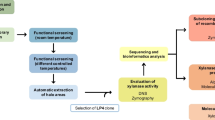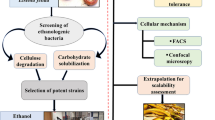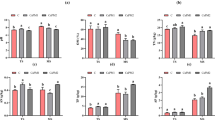Abstract
Vermicomposting is a promising method for corn stover management to achieve bioresource recovery and environmental protection. Most β-glucosidases, which limit the cellulose degradation rate during vermicomposting of corn stover, belong to glycoside hydrolase family 1 (GH1). This study was conducted with different earthworm densities to quantify the GH1 gene abundance and investigate the evolution of GH1 cellulase-producing microbial communities using qPCR and pyrosequencing. The results showed that β-glucosidase activity, GH1 gene abundance, TOC, and microbial communities carrying the GH1 gene were affected by processing time and earthworm density. After introducing earthworms, β-glucosidase activity increased to 1.90–2.13 U/g from 0.54 U/g. The GH1 gene abundance of treatments with earthworms (5.82E+09–6.70E+09 copies/g) was significantly higher than that of treatments without earthworms (2.48E+09 copies/g) on Day 45. Earthworms increased the richness of microbial communities. The relative abundances of Sphingobium and Dyadobacter, which are dominant genera harboring the GH1 gene, were increased by earthworms to peak values of 23.90% and 11.20%, respectively. Correlation analysis showed that Sphingobium, Dyadobacter, Trichoderma, and Starkeya were positively associated with β-glucosidases. This work sheds new light on the mechanism of cellulose degradation during vermicomposting at the molecular level.






Similar content being viewed by others
Data availability
The data is available with corresponding authors and available on reasonable request.
References
Busse H, Denner EBM, Buczolits S, Salkinoja-Salonen M, Bennasar A, Kampfer P (2003) Sphingomonas aurantiaca sp. nov., Sphingomonas aerolata sp. nov. and Sphingomonas faeni sp. nov., air- and dustborne and Antarctic, orange-pigmented, psychrotolerant bacteria, and emended description of the genus Shingomonas. Int J Syst Evol Microbiol 53:1253–1260
Cairns JRK, Esen A (2010) Beta-Glucosidases. Cell Mol Life Sci 67:3389–3405
Cao Y, Tian Y, Wu Q, Li J, Zhu H (2021) Vermicomposting of livestock manure as affected by carbon-rich additives (straw, biochar and nanocarbon): a comprehensive evaluation of earthworm performance, microbial activities, metabolic functions and vermicompost quality. Bioresour Technol 320:124404
Chan CS, Sin LL, Chan KG, Shamsir MS, Manan FA, Sani RK, Goh KM (2016) Characterization of a glucose-tolerant β-glucosidase from Anoxybacillus sp. DT3-1 Biotechnol Biofuels Bioprod 9:174
Chatterjee D, Dutta SK, Kikon ZJ, Kuotsu R, Sarkar D, Satapathy BS, Deka BC (2021) Recycling of agricultural wastes to vermicomposts: characterization and application for clean and quality production of green bell pepper (Capsicum annuum L.). J Clean Prod 315:128115
Chen Y, Zhang Q, Zhang Y, Chen J, Zhang D, Tong J (2015) Changes in fibrolytic enzyme activity during vermicomposting of maize stover by an anecic earthworm Amynthas hupeiensis. Polym Degrad Stab 120:169–177
Chen Y, Zhang Y, Shi X, Xu L, Zhang L, Zhang L (2022) The succession of GH6 cellulase-producing microbial communities and temporal profile of GH6 gene abundance during vermicomposting of maize stover and cow dung. Bioresour Technol 344:126242
Cui G, Lü F, Hu T, Zhang H, Shao L, He P (2022) Vermicomposting leads to more abundant microplastics in the municipal excess sludge. Chemosphere 307:136042
de Giuseppe PO, Souza TACB, Souza FHM, Zanphorlin LM, Machado CB, Ward RJ, Jorge JA, Furriel RPM, Murakami MT (2014) Structural basis for glucose tolerance in GH1 β-glucosidases. Acta Crystallogr D Biol Crystallogr 70:1631–1639
Devi J, Deb U, Barman S, Das S, Bhattacharya SS, Tsang YF, Lee JH, Kim KH (2020) Appraisal of lignocellusoic biomass degrading potential of three earthworm species using vermireactor mediated with spent mushroom substrate: compost quality, crystallinity, and microbial community structural analysis. Sci Total Environ 716:135215
El-Bondkly AMA (2014) Chapter 28 - Sequence analysis of industrially importantgenes from Trichoderma. In: Biotechnology and Biology of Trichoderma. Elsevier, Amsterdam, The Netherlands, pp 377–392
Fu Y, Yin Z, Wu L, Yin C (2014) Diversity of cultivable beta-glycosidase-producing micro-organisms isolated from the soil of a ginseng field and their ginsenosides-hydrolysing activity. Lett Appl Microbiol 58(2):138–144
Han Y, Liu W, Chang N, Sun L, Bello A, Deng L, Zhao L, Egbeagu UU, Wang B, Zhao Y, Zhao M, Bi R, Jong C, Xu X, Sun Y (2023) Exploration of β-glucosidase-producing microorganisms community structure and key communities driving cellulose degradation during composting of pure corn straw by multi-interaction analysis. J Environ Manage 325:116694
Harindintwali JD, Zhou J, Yu X (2020) Lignocellulosic crop residue composting by cellulolytic nitrogen-fixing bacteria: a novel tool for environmental sustainability. Sci Total Environ 715:136912
Henrissat B (1991) A classification of glycosyl hydrolases based on amino acid sequence similarities. Biochem J 280(2):309–316
Hřebečková T, Wiesnerová L, Hanč A (2020) Changes in layers of laboratory vermicomposting using spent mushroom substrate of Agaricus subrufescens P. J Environ Manage 276:111340
Huang K, Zhang Y, Xu J, Guan M, Xia H (2022) Feasibility of vermicomposting combined with room drying for enhancing the stabilization efficiency of dewatered sludge. Waste Manag 143:116–124
Kaur J, Chadha BS, Kumar BA, Kaur GS, Saini HS (2007) Purification and characterization of β-glucosidase from Melanocarpus sp. MTCC 3922. Electron J Biotechnol 10(2):261–270
Khan MFS, Akbar M, Xu Z, Wang H (2021) A review on the role of pretreatment technologies in the hydrolysis of lignocellulosic biomass of corn stove. Biomass Bioenergy 155:106276
Kharrazi SM, Younesi H, Abedini-Torghabeh J (2014) Microbial biodegradation of waste materials for nutrients enrichment and heavy metals removal: an integrated composting-vermicomposting process. Int Biodeter Biodegr 92:41–48
Koul B, Yakoob M, Shah MP (2022) Agricultural waste management strategies for environmental sustainability. Environ Res 206:112285
Kurian JK, Nair GR, Hussain A, Raghavan GSV (2013) Feedstocks, logistics and pre-treatment processes for sustainable lignocellulosic biorefineries: a comprehensive review. Renew Sustain Energy Rev 25:205–219
Kutu FR, Mokase TJ, Dada OA, Rhode OHJ (2019) Assessing microbial population dynamics, enzyme activities and phosphorus availability indices during phospho-compost production. Int J Recycling Org 8:87–97
Lang E, Lapidus A, Chertkov O, Brettin T, Detter JC, Han C et al (2009) Complete genome sequence of Dyadobacter fermentans type strain (NS114T). Stand Genomic Sci 1:133–140
Matsuzawa T, Jo T, Uchiyama T (2016) Crystal structure and identification of a key amino acid for glucose tolerance, substrate specificity, and transglycosylation activity of metagenomic β-glucosidase Td2F2. FEBS J 283(12):2340–2353
Meng Q, Wang S, Niu Q, Yan H, Li Q (2021) The influences of illite/smectite clay on lignocellulose decomposition and maturation process revealed by metagenomics analysis during cattle manure composting. Waste Manag 127:1–9
Mondini C, Fornasier F, Sinicco T (2004) Enzymatic activity as a parameter for the characterization of the composting process. Soil Biol Biochem 36:1587–1594
Moraïs S, Barak Y, Caspi J, Hadar Y, Lamed R, Shoham Y, Wilson D, Bayer E (2010) Cellulase-xylanase synergy in designer cellulosomes for enhanced degradation of a complex cellulosic substrate. mBio 1(5):e00285–e00210
Podar M, Turner J, Burdick LH, Pelletier DA (2020) Complete genome sequence of Starkeya sp. strain ORNL1, a soil alphaproteobacterium isolated from the rhizosphere of Populus deltoides. Microbiol Resour Announc 9(27):e00644–e00620
Sarkar J, Mridha D, Sarkar J, Orasugh JT, Gangopadhyay B, Chattopadhyay D, Roychowdhury T, Acharya K (2021) Synthesis of nanosilica from agricultural wastes and its multifaceted applications: a review. Biocatal Agric Biotechnol 37:102175
Scaglia B, Nunes RR, Rezende MOO, Tambone F, Adani F (2016) Investigating organic molecules responsible of auxin-like activity of humic acid fraction extracted from vermicompost. Sci Total Environ 562:289–295
Simmons CW, Reddy AP, D’haeseleer P, Khudyakov J, Billis K, Pati A, Simmons BA, Singer SW, Thelen MP, VanderGheynst JS (2014) Metatranscriptomic analysis of lignocellulolytic microbial communities involved in high-solids decomposition of rice straw. Biotechnol Biofuels 7(1):1–13
Souza FHM, Inocentes RF, Ward RJ, Jorge JA, Furriel RPM (2013) Glucose and xylose stimulation of a β-glucosidase from the thermophilic fungus Humicola insolens: a kinetic and biophysical study. J Mol Catal B: Enzym 94:119–128
Tiwari R, Kumar K, Singh S, Nain L, Shukla P (2016) Molecular detection and environment-specific diversity of glycosyl hydrolase family 1 β-glucosidase in different habitats. Front Microbiol 7:1597
Wang X, Wang S (2020) Soil microbiome screening for carbon fixation and nitrogen metabolism pathways based on KEGG database. Trans Chin Soc Agric Mach 51(8):311–319
Wang N, Wang W, Jiang Y, Dai W, Li P, Yao D, Wang J, Shi Y, Cui Z, Cao H, Dong Y, Wang H (2021) Variations in bacterial taxonomic profiles and potential functions in response to the gut transit of earthworms (Eisenia fetida) feeding on cow manure. Sci Total Environ 787:147392
Woodward J (1991) Synergism in cellulase systems. Bioresour Technol 36(1):67–75
Wüst PK, Horn MA, Drake HL (2011) Clostridiaceae and Enterobacteriaceae as active fermenters in earthworm gut content. ISME J 5:92–106
Zabed H, Sahu JN, Boyce AN, Faruq G (2016) Fuel ethanol production from lignocellulosic biomass: an overview on feedstocks and technological approaches. Renew Sustain Energy Rev 66:751–774
Zang X, Liu M, Fan Y, Xu J, Xu X, Li H (2018) The structural and functional contributions of β-glucosidase-producing microbial communities to cellulose degradation in composting. Biotechnol Biofuels 11:51
Zhang X, Ma B, Liu J, Chen X, Li S, Su E, Gao L, Li H (2020) β-Glucosidase genes differentially expressed during composting. Biotechnol Biofuels 13:174
Zhou Z, Ju X, Chen J, Wang R, Zhong Y, Li L (2021) Charge-oriented strategies of tunable substrate affinity based on cellulase and biomass for improving in situ saccharification: a review. Bioresour Technol 319:124159
Acknowledgements
The authors appreciate the Tutools platform (http://www.cloudtutu.com), a free online data analysis website. The authors express their gratitude to the anonymous reviewers for their valuable comments and suggestions.
Funding
This work was supported by the Strategic Priority Research Program of the Chinese Academy of Sciences (XDA28110201), the National Natural Science Foundation of China (31872178), and the National Natural Science Foundation of China (32171913).
Author information
Authors and Affiliations
Contributions
Yuxiang Chen: conceptualization, methodology, supervision, funding acquisition, project administration, writing—review and editing. Jiaolin Li: writing—original draft, writing—review and editing. Tingting Zhao: data curation. Yan Zhang: data curation. Lei Zhang: data curation. Lixin Xu: methodology, supervision, data curation, project administration.
Corresponding author
Ethics declarations
Ethical approval
The present study was carried out at the College of Biological and Agricultural Engineering, Jilin University, Changchun, China. The experimental protocol used in the study was approved by the Institutional Animal Care and Use Committee of Jilin University, Changchun, China.
Consent to participate
All authors agree to participate in this study.
Consent for publication
All authors allow the publication of this paper.
Competing interests
The authors declare no competing interests.
Additional information
Responsible Editor: Robert Duran
Publisher’s note
Springer Nature remains neutral with regard to jurisdictional claims in published maps and institutional affiliations.
Supplementary information
ESM 1:
Fig. S1 The heatmap of microbial community structure during vermicomposting at the genus level. “T” denotes substrates composed of 60% corn stover and 40% cow dung. “i” means the initial samples, and “p” means the samples after having been pre-composted for 15 days. “x” of Txy denotes the earthworm density, and “x” ranging from 1 to 4 denotes 0, 60, 120 and 180 earthworms/kg substrate. “y” of Txy denotes the sampling time series, and “y” including 3 and 4 denotes day 30 and day 45, respectively
Rights and permissions
Springer Nature or its licensor (e.g. a society or other partner) holds exclusive rights to this article under a publishing agreement with the author(s) or other rightsholder(s); author self-archiving of the accepted manuscript version of this article is solely governed by the terms of such publishing agreement and applicable law.
About this article
Cite this article
Chen, Y., Li, J., Zhao, T. et al. The temporal profile of GH1 gene abundance and the shift in GH1 cellulase-producing microbial communities during vermicomposting of corn stover and cow dung. Environ Sci Pollut Res 30, 84035–84045 (2023). https://doi.org/10.1007/s11356-023-28341-y
Received:
Accepted:
Published:
Issue Date:
DOI: https://doi.org/10.1007/s11356-023-28341-y




